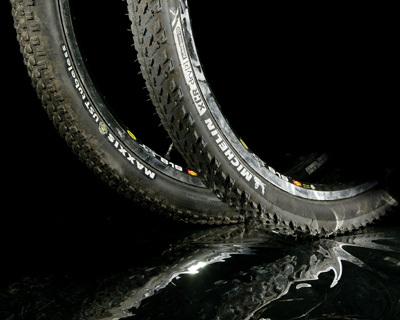Enduro Tubeless Tyres
 Michelin XCR Dry2 £29.95
Michelin XCR Dry2 £29.95
Size: 2.0in / UST tubeless / 127tpi / Kevlar bead / £27.95 for the tubed version / Weight: 662g / Contact: Michelin 01782 401754
MBR rating: 8/10
Maxxis Larsen TT UST £28.99
Size: 2.0in / Kevlar bead / 120tpi / UST Tubeless / Tubed version 2.0in £24.99, 2.35in single ply £19.99, 2.35in double ply £23.99 / Weight: 715g / Contact: MMA 01792 467467
MBR rating: 7/10
The reason we think these two tyres are suitable for marathon use is because of the terrain these events typically cover. To get the distance. organisers often use long fire road sections and miles of tarmac, with only the odd stretch of singletrack. To cover the terrain quickly a tyre has to be nippy on the fire roads but still cope with the short technical sections. Since you’re riding a lot of this blind and also carrying a lot of speed into the singletrack, usually behind someone else and unsighted, we think a tubeless is the only tyre that can offer adequate pinch-flat protection — especially if it’s a mid-size tyre such as these two.
The XCR Dry2 is from Michelin’s Expert range and uses dual-compound technology, which means the tread has a hard rubber centre with soft covering. The theory is that the soft outer offers good grip while the hard centre reinforces the knobs and increases puncture protection. The Larsen TT uses Maxxis’ new LUST Tubeless Technology, which is just a lightweight sidewall that the company claims ‘offers better puncture resistance’ and ‘lower weight’. These two things don’t usually go hand in hand, but we’ll see how the TT holds up.
One of the biggest problems with UST tyres is getting them to hold air. We fitted both tyres to Mavic rims and while the XCR Dry 2 was a tight fit it only required some soapy water on the bead to get it to seat. From them on it retained air as well as a standard tubed tyre. One of the Maxxis tyres also seated first time but the other required some sealant and 10 minutes of sweating with a track pump before it popped into place. Both the Maxxis tyres then leaked air and needed topping up every couple of days. The beads on them are harder with less of a rubber coating than the XCR Dry 2, which could explain why they leak.
With its low tread pattern, the XCR Dry 2 accelerates quickly and once up to race pace retains a lot of momentum. However, semi-slicks on singletrack can be dodgy, especially if the trail is damp. The rear XCR tends to spin out on roots and loose ascents. It also locks up easily under braking and offers little traction when descending on grass or gravel.
The Larsen TT is more of a conventional knobbly with small regular knobs and a more definite edge. It’s not as quick as the XCR Dry 2 but we found it’s better in sticky conditions and on the loose climbs. The tread fills with mud easier than the XCR Dry 2 but it clears quickly. The Larsen TT is a slightly bigger 2.0in than the Michelin, so offers more cushioning and grip. It’s packing an extra 50g per tyre but we couldn’t tell when riding. Braking is confident and more predictable with the TTs.
Verdict
The XCR Dry 2 makes you feel like you’re constantly riding with a tailwind and the low drag means you can push a harder gear on those long gravel road climbs. However, it takes a deft touch to ride it quickly through the singletrack. You can’t take liberties with this tyre on the front and let it drift in the corners. If you want to increases traction we’d recommend one of Michelin’s XCR X’Treme tyres up front.
The Larsen TT lags behind the Michelin in terms of straight-line speed but it’s a better tyre for all-round use. In this respect we’d have rated it above the XCR, but the air-loss is a major flaw. Adding sealant could help, but it’ll increase rotating weight, and why bother when all the best UST tubeless tyres don’t need it.















